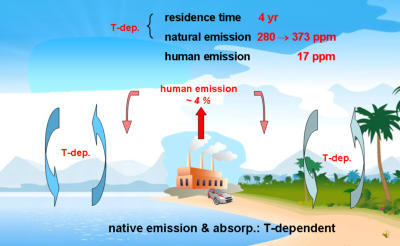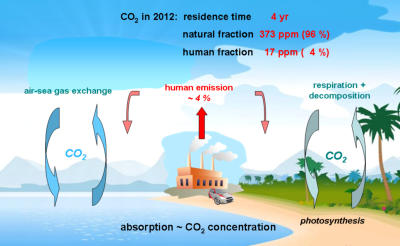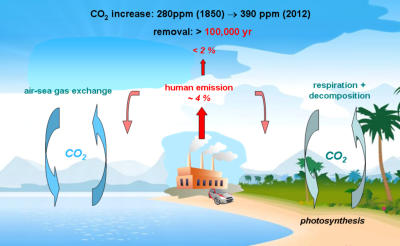

d) Carbon Cycle
In their scenarios the IPCC emanates from the assumption, that the actually observed CO 2 increase is almost exclusively determined by anthropogenic emissions (AR5 [1]), whereas natu- ral emissions are considered to be independent of any solar or temperature variations, this in contradiction to paleoclimatic ice-core data, which show a delay of the CO 2 emission to the temperature of about 800 years (Petit et al. 1999 [2]), and this also in discrepancy to actual observations with a delay of about 9 months (McRae 2008 [3]; Humlum et al. 2013 [4]; Salby 2013 [5]; Salby 2016 [6]; Salby 2018 [7]). The emissions of CO 2 to the atmosphere and their uptake by extraneous reservoirs are considered in more or less refined theoretical models, which are used to replicate the carbon cycle. From these models climate scientists presume that this cycle has come out of balance due to the increasing human emissions from fossil fuel combustion and land use change. Although all anthropogenic emissions over the Industrial Era are not more than 1% of the total emissions and uptake over this period - actually they contribute 4.3 % to the CO 2 emissions per year - the IPCC assumes that the uptake is already limited and about half of it, the so called airborne fraction, cumu- lates in the atmosphere. This is made responsible for the rapidly ri- sing atmospheric CO 2 concentration, which in 1850 was about 280 ppm and over the Industrial Era increased up to 390 ppm in 2012 (average over 10 years from 2007-2016: 393 ppm). The IPCC further assumes that the removal of human-emitted CO 2 from the atmosphere by natural processes will take up to a few hundred thousand years, even when anthropogenic emissions could completely be stopped. As the rising CO 2 concentrations go along with an increasing greenhouse effect and, thus, a further global warming, a better understanding of the carbon cycle is a necessary prerequisite for all future climate change predictions.1. Order Absorption
Different to the IPCC's accounting scheme we emanate from a carbon cycle, which shows no saturation in the uptake, in agreement with observations, but the absorption is consi- dered as a first order process, scaling pro- portional with the actual CO 2 concentration in the atmosphere (Harde 2017 [8], Harde 2019 [9]). This approach is well justified for natural ab- sorption or decay processes, and it is sup- ported by the observation of a pure expo- nential decline of the 14 C-isotope in the atmosphere after the stop of nuclear bomb tests in 1964. With this modification we find a CO 2 residence time of not more than 4 years, which is also in good agreement with the observed 14 C-decay time. The natural emissions then contribute 96% and the human emissions only 4% to the total concen- tration in agreement with the respective emission rates.Temperature Dependence
We explain the stronger increasing concentration over the Industrial Era from 280 to 420 ppm mostly by a temperature dependent resi- dence time and a T-dependent natural emission rate. This is in contradiction to the IPCC, which exclusively traces the ascending CO 2 level back to the accumulating anthropogenic emissions and denies any larger natural va- riations, although paleoclimatic and also ac- tual investigations show significant changes of the CO 2 concentration with temperature.Comparison with Observations
Our approach reproduces the concentrations at glacial and interglacial times as well as the slightly exponential increase with the onset of the Industrial Revolution. Comparison of the direct CO 2 measurement at Mauna Loa with a simulation, which uses respective air temperature data of Hawaii together with the anthropogenic emissions over recent years, documents this excellent agreement (Harde 2019 [9]). From this ana- lysis we deduce that for the meanwhile 145 ppm CO 2 increase over the Industrial Era human emissions were only donating about 15 %, which is not more than 5% of the total con- centration. Recent studies of the absorption time of atmospheric CO 2 even suggest a still lower anthropo- genic contribution (Harde&Salby 2021 [10]; Salby&Harde 2021 [11,12]; Salby&Harde 2022 [13]; Harde 2023a [14]; Harde 2023b [15]; Harde 2025 [16]). So, under conditions of an increasing imbalance between troposphere and extraneous reservoirs this reduces to only 9% over the Industrial Era, which are 3 % of the atmospheric CO 2 concentration.Consequences
Thus, not anthropogenic emissions but mainly natural processes, in particular the tempera- ture, have to be considered as the dominating impacts for the observed CO 2 increase over the last 270 yrs and also over paleoclimate periods. With these anthropogenic emissions of 15 % or less and a quota of 30 % caused by CO 2 to global warming (Harde 2017 [17], Harde 2018 [18], Harde 2022 [19]) the human contribution to the increased temperature of about 0.9°C over the last century could not have been more than 4.5 % or 0.04°C. This completely negligible contribution by no means justifies any intended reduction of fossil fuels, only prospective resource protection can be discussed. Instead, political delusion destroys a prospering industry and burdens future generations with additional debts of unprecedented dimensions.References
1. IPCC-AR5, T. F. Stocker, D. Qin, G.-K. Plattner et al., Eds., 2013: Fifth Assessment Report: Climate Change 2013: The Physical Science Basis, Cambridge University Press, New York, NY, 2014. 2. Petit, J.-R., Jouzel, J., Raynaud, D., Barkov, N.I., Barnola, J.-M., Basile, I., Bender, M., Chappellaz, J., Davis, M., Delaygue, G., et al., 1999: Climate and atmospheric history of the past 420,000 years from the Vostok ice Core, Antarctica, Nature 399 (6735), 429–436. 3. A. McRae, 2008: Carbon Dioxide Is Not The Primary Cause Of Global Warming, http://icecap.us/images/uploads/CO2vsTMacRae.pdf 4. O. Humlum, K. Stordahl, J. E. Solheim, 2013: The phase relation between atmospheric carbon dioxide and global temperature, Global and Planetary Change 100, pp. 51-69, 2013. 5. M. L. Salby, 2013: Relationship Between Greenhouse Gases and Global Temperature, Video Presentation, April 18, 2013. Helmut-Schmidt-University Hamburg, https://www.youtube.com/watch?v=2ROw_cDKwc0 6. M. L. Salby, 2016: Atmospheric Carbon, Video Presentation, July 18, 2016. University College London. https://youtu.be/3q-M_uYkpT0. 7. M. L. Salby, 2018: What is Really Behind the Increase of Atmospheric CO 2 ? Helmut-Schmidt-University Hamburg, 10. October 2018, https://youtu.be/rohF6K2avtY 8. H. Harde, 2017: Scrutinizing the carbon cycle and CO 2 residence time in the atmosphere, Global and Planetary Change 152, pp. 19-26 (2017). http://dx.doi.org/10.1016/j.gloplacha.2017.02.009, Free download of the Manuscript 9. H. Harde, 2019: What Humans Contribute to Atmospheric CO 2 : Comparison of Carbon Cycle Models with Observations, Earth Sciences. Vol. 8, No. 3, pp. 139-159 (2019). https://doi.org/10.11648/j.earth.20190803.13 10. H. Harde, M. L. Salby, 2021: What Controls the Atmospheric CO 2 Level? Science of Climate Change, Vol. 1, No.1, pp. 54 - 69, https://doi.org/10.53234/scc202106/22. 11. M. L. Salby, H. Harde, 2021: Control of Atmospheric CO 2 - Part I: Relation of Carbon 14 to Removal of CO 2 , Science of Climate Change 2021, Vol. 1, No. 2, pp. 177 - 195, https://doi.org/10.53234/scc202112/30. 12. M. L. Salby, H. Harde, 2021: Control of Atmospheric CO 2 - Part II: Influence of Tropical Warming Science of Climate Change 2021, Vol. 1, No. 2, pp. 196 - 212, https://doi.org/10.53234/scc202112/12. 13. M. L. Salby, H. Harde, 2022: Theory of Increasing Greenhouse Gases, Science of Climate Change 2022, Vol. 2, No.3, pp. 212 - 238, https://doi.org/10.53234/scc202212/17 14. H. Harde, 2023: Understanding Increasing Atmospheric CO 2 , Science of Climate Change 2023, Vol. 3, No. 1, pp. 46 - 67, https://doi.org/10.53234/scc202301/23 15. H. Harde, 2023: Reply to a Comment on: Understanding Increasing Atmospheric CO 2 Science of Climate Change 2023, Vol. 3, No. 1, pp. 114 - 118, https://doi.org/10.53234/scc202301/28 16. H. Harde, 2025: Atmospheric CO 2 : What Physics Dictates Proceedings of the Oslo-Gardermoen Conference, August 30 - 31, 2025, Science of Climate Change 2025, Vol. 5.4, pp. 66 - 76, https://doi.org/10.53234/scc202511/12. 17. H. Harde, 2017: Radiation Transfer Calculations and Assessment of Global Warming by CO 2 , International Journal of Atmospheric Sciences, Volume 2017, Article ID 9251034, pp. 1-30 (2017), https://doi.org/10.1155/2017/9251034 18. H. Harde, 2018: Was tragen CO 2 und die Sonne zur globalen Erwärmung bei? 12th International EIKE Klima- und Energiekonferenz, and 13th International Conference on Climate Change (ICCC-13), München, 23. a. 24. November, 2018, https://www.youtube.com/watch?v=ldrG4mn_KCs&feature=youtu.be 19. H. Harde, 2022: How Much CO 2 and the Sun Contribute to Global Warming: Comparison of Simulated Temperature Trends with Last Century Observations, Science of Climate Change, vol. 2, no. 2, pp. 105-133, https://doi.org/10.53234/scc202206/10


Physics & Climate















